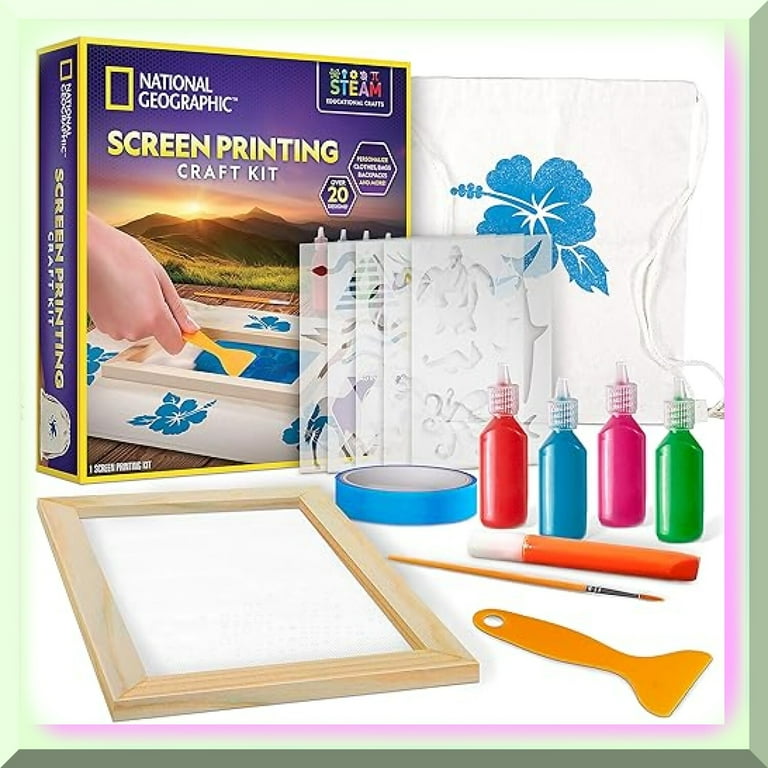Understanding Silk Screen Printing: Advice for Creating Stunning Layouts
If you're wanting to master silk screen printing, you'll require more than simply enthusiasm. It needs a solid understanding of techniques, the right devices, and thorough prep work. You'll find just how to prepare your art work and deal with usual concerns that can occur throughout the process. By the end, you'll prepare to produce sensational designs that show your unique style. But initially, let's explore the necessary basics that prepared for your success.
Recognizing the Basics of Silk Screen Printing
Silk display printing, often called screen printing, is a functional method for moving designs onto numerous products. You'll find it's optimal for printing on fabrics, paper, plastic, and a lot more. The procedure includes creating a pattern, or display, that enables ink to pass with only in specific locations, creating lively and tidy styles.
To get started, you'll require to prepare your art work, guaranteeing it remains in an appropriate layout. screen printing kit. When you've obtained your design ready, you'll layer your display with a light-sensitive solution and subject it to light. This step develops a stencil of your layout on the display
After washing out the unexposed emulsion, you're readied to print. Align your display over your product, use ink, and utilize a squeegee to push the ink with the screen. It's all regarding practice and patience, so don't be reluctant to experiment and fine-tune your method as you go.
Vital Tools and Materials You'll Need
To begin with silk screen printing, you'll require a few basic products like screens, mops, and ink. You can check out innovative tools that enhances your printing high quality and effectiveness once you're comfortable. Allow's review what you'll require to assure your tasks succeed from the beginning.
Basic Silk Display Products
Starting on a silk display printing task needs a few essential devices and materials to guarantee your success. You'll need a silk screen frame, which holds the mesh that transfers your style. A squeegee is important for pushing ink via the screen onto your substrate. Don't neglect the ink itself; choose shades that suit your design and the product you're printing on. A source of light is critical for exposing your display, together with solution to develop your stencil. You'll also need a proper office, ideally one that's complimentary and well-lit from dust. Ultimately, supply up on cleansing supplies to preserve your tools and maintain your displays in great problem. With these fundamentals, you prepare to plunge into your task!
Advanced Printing Devices
When you prepare to take your silk screen printing to the next degree, buying advanced printing tools can make a considerable distinction. A top notch screen printing machine is essential; appearance for a multi-color press that permits accurate registration and quicker production. You'll also want to upgrade to a much more effective direct exposure device to ensure your styles are vibrant and sharp.
Consider purchasing a dependable warmth resource, like a conveyor clothes dryer, for also healing of inks. Do not ignore specialized inks; water-based and discharge inks give exceptional outcomes on numerous materials. Ultimately, a good collection of mops and emulsion scoop coater will certainly streamline your process, offering your designs that expert side.
Preparing Your Artwork for Printing
Preparing your art work for silk display printing is essential to achieving vibrant, professional results. Beginning by validating your layout is in the appropriate layout-- vector data like.AI or.EPS job best.
As soon as your data prepares, produce a different layer for every color in your layout. This'll make it less complicated throughout the printing process. Don't forget to include enrollment marks to line up colors properly.
Also, take into consideration the mesh matter of your screen; better information may require a higher mesh count. Save your artwork with a resolution of at least 300 DPI to guarantee crisp prints. By adhering to these steps, you'll establish yourself up for a successful printing experience and bring your designs to life perfectly.
The Display Printing Process: Step-by-Step
Now that you've prepared your artwork, it's time to focus on the screen printing process itself. You'll begin by preparing your screen, guaranteeing it awaits the ink application. From there, you'll explore various printing techniques to attain the most effective results for your task.
Preparing Your Display
Getting your display all set is a crucial action in the silk screen printing procedure. Clean the screen thoroughly to eliminate any residue, dirt, or grease. Use a degreaser and wash it well to assure a smooth surface for your emulsion. Next, use a light layer of solution equally across the display making use of a scoop coater. Make certain to do this in a poorly lit location to protect against premature exposure. Enable the solution to completely dry completely prior to revealing it to your design. Once completely dry, position your openness on the screen and make use of a source of light to expose the style. After direct exposure, rinse the unexposed emulsion, and you'll have your screen gotten ready for printing.
Printing Strategies Explained
When your screen is all set, you can plunge into the interesting process of printing. Next, put your ink onto one side of the display and utilize a squeegee to pull the ink across the layout. Clean your screen quickly to prevent ink from obstructing the mesh and drying out.
Tips for Achieving Vibrant Colors
While attaining vibrant shades in silk display printing might appear tough, you can conveniently elevate your styles with a few key techniques. Select top quality inks particularly made for silk display printing; they offer much better coloring and protection. Blending inks properly can likewise improve vibrancy-- experiment with ratios to discover the best mix that stands out.

Lastly, do not ignore healing your prints correctly. Proper heat establishing assurances the shades bond with the textile, keeping their vibrancy over time. By applying these methods, you'll produce sensational, captivating designs that truly shine.
Troubleshooting Usual Printing Issues
Despite vivid colors in your layouts, silk display printing can occasionally present difficulties. One typical issue is ink bleeding, which usually happens when you utilize excessive ink or do not allow the previous layer completely dry completely. To prevent this, use a squeegee with simply the appropriate stress and ensure each layer is dry prior to adding a lot more.
If your layout isn't lining up properly, verify your registration marks and make adjustments to your screens. Clean your displays completely before starting your print run.
Last but not least, if the ink isn't sticking well to the material, take into consideration the material kind and the treating process. See to it you're utilizing the appropriate ink which you're curing it at the ideal temperature level. Troubleshooting these common concerns will certainly assist you accomplish sensational results.
Trying out Effects and techniques
Experimenting with various techniques and impacts can boost your silk screen printing tasks to new elevations. You can likewise play with appearances-- using different squeegee methods or including materials like sponges or brushes adds dimension to your prints.
Take into consideration using specialized inks, find more such as glow-in-the-dark or metallic, to give your designs an unanticipated twist. You may even discover stenciling, where you can cut complex designs for magnificent effects.
Don't forget about substratum variations! Printing on fabrics, wood, or paper can yield various outcomes that boost your task's feeling.
Lastly, keep a journal of your experiments. Recording your failures and successes will direct your future check these guys out developments and aid you fine-tune your style. Welcome the process, and enjoy the trip of uncovering what works best for you!
Often Asked Inquiries
Just how Do I Tidy and Maintain My Display Printing Equipment?
To clean up and maintain your display printing tools, frequently scrub screens with an ideal cleaner, clean mops after usage, and store every little thing in a completely dry, dust-free setting. Maintaining points tidy assurances better prints and longer-lasting devices.

Can I Publish on Products Aside From Material?
Yes, you can print on materials besides fabric! Consider making use of plastic, wood, or paper. Just ensure your inks and screens work with those surface areas for the very best outcomes. Experiment and enjoy!
What Is the very best Way to Store Displays and Inks?
To keep screens and inks effectively, maintain displays upright in a trendy, dry area, and cover them to avoid dirt. Shop inks in impermeable containers, away from direct sunlight, to preserve their high quality and uniformity.
How Do I Select the Right Mesh Count for My Task?
Picking the appropriate mesh matter relies on your design's information and ink type. For great information, go higher, like 200 mesh (screen printing kit). For strong layouts, a lower matter, around 110, works finest. Experiment to find your optimal match.
What Are the Environmental Influences of Silk Display Printing?
Silk display printing can have environmental impacts, like chemical waste and water usage. You can minimize these by using environmentally friendly inks, recycling materials, and properly getting rid of chemicals to minimize your job's environmental footprint.
Silk screen printing, often called screen printing, is a versatile approach for transferring designs onto numerous products. Align your display over your product, apply ink, and use a squeegee to press the ink with the screen.To obtain begun with silk screen printing, you'll need a couple of standard supplies like displays, mops, click resources and ink.When you're prepared to take your silk screen printing to the following level, spending in advanced printing tools can make a significant difference.Getting your display prepared is an important step in the silk display printing process.